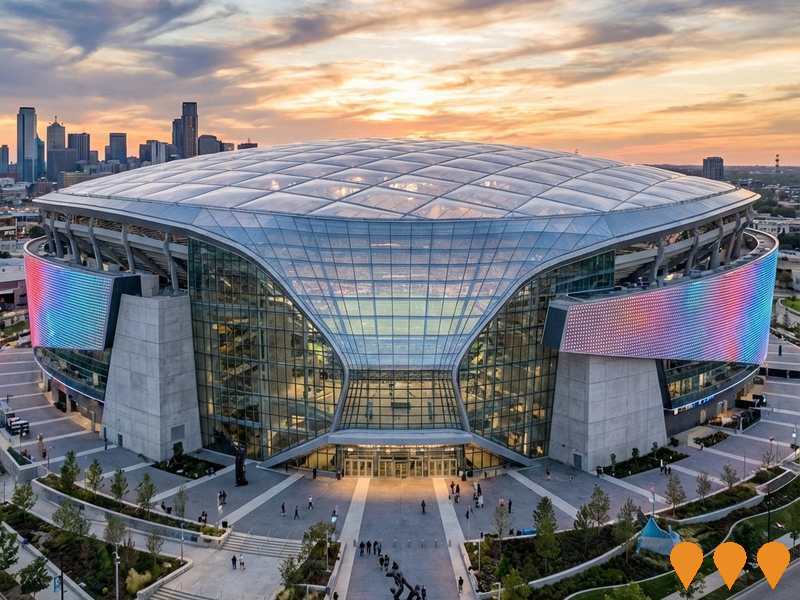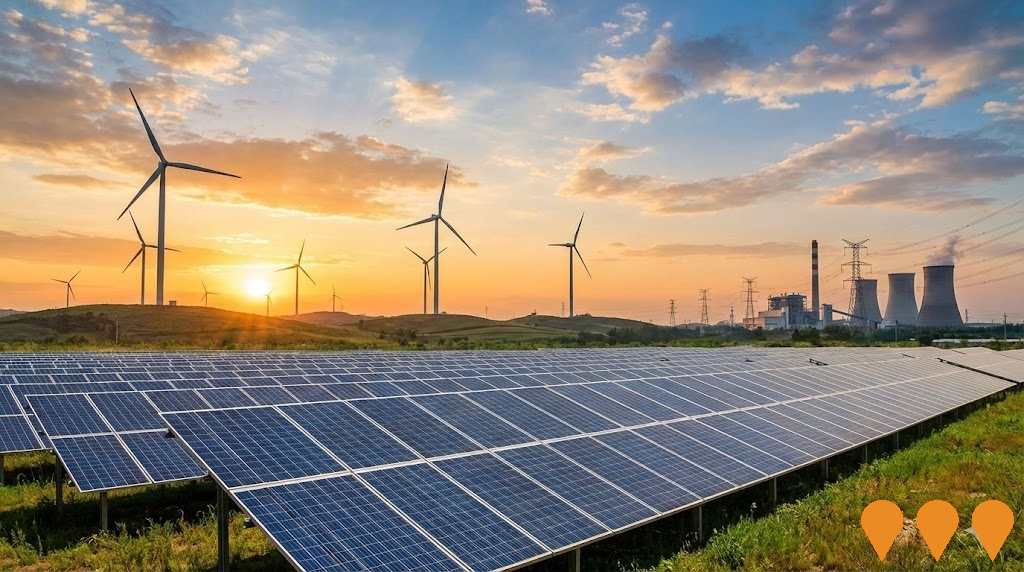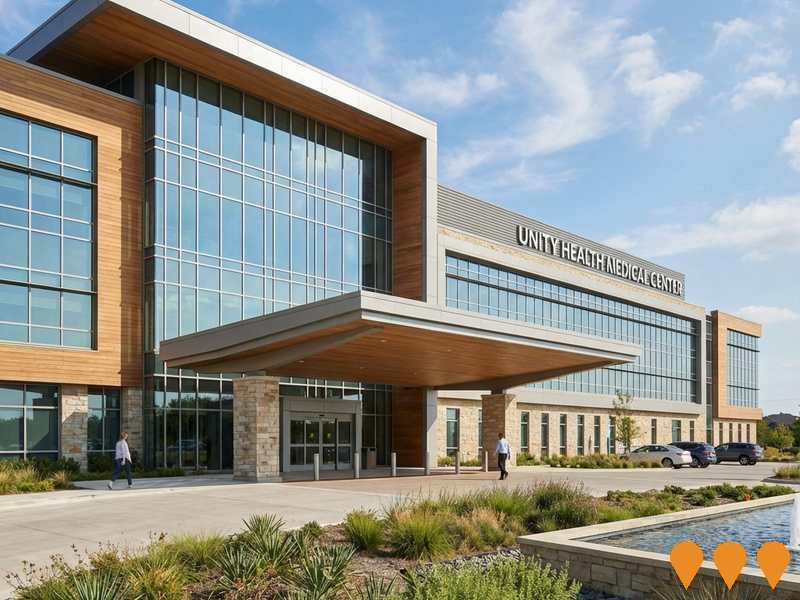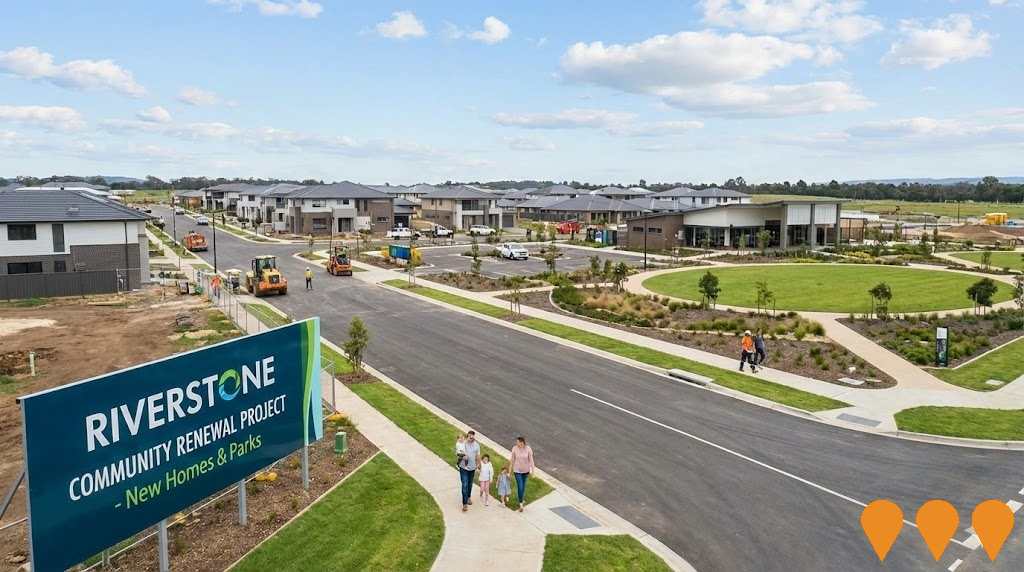Chart Color Schemes
est. as @ -- *
ABS ERP | -- people | --
2021 Census | -- people
Sales Activity
Curious about local property values? Filter the chart to assess the volume and appreciation (including resales) trends and regional comparisons, or scroll to the map below view this information at an individual property level.
Find a Recent Sale
Sales Detail
Population
Newcomb - Moolap has seen population growth performance typically on par with national averages when looking at short and medium term trends
Newcomb-Moolap's population is around 15,228 as of Aug 2025. This reflects a decrease since the 2021 Census which reported a population of 15,462 people. The change is inferred from ABS estimated resident population of 15,202 in June 2024 and an additional 103 validated new addresses since the Census date. This level of population equates to a density ratio of 351 persons per square kilometer. Population growth was primarily driven by overseas migration.
AreaSearch adopts ABS/Geoscience Australia projections for each SA2 area, released in 2024 with 2022 as the base year. For areas not covered, AreaSearch utilises VIC State Government's Regional/LGA projections from 2023 with adjustments made employing a method of weighted aggregation of population growth from LGA to SA2 levels. Growth rates by age group are applied across all areas for years 2032 to 2041. Projected population growth shows an above median increase nationally, with the area expected to increase by 2,161 persons to 2041 based on latest numbers, reflecting a total increase of 13.9% over the 17 years.
Frequently Asked Questions - Population
Development
AreaSearch assessment of residential development drivers sees a low level of activity in Newcomb - Moolap, placing the area among the bottom 25% of areas assessed nationally
Newcomb - Moolap has seen approximately 37 dwellings granted development approval annually. Between financial years FY-21 and FY-25, around 188 homes were approved, with an additional 5 approved so far in FY-26. The population decline in recent years suggests that new supply has likely been meeting demand, providing buyers with good choices.
The average expected construction cost of new homes is $337,000, which is below regional levels, indicating more affordable housing options for buyers. In the current financial year, commercial development approvals totaling $28.1 million have been recorded, demonstrating strong commercial development momentum. Compared to the Rest of Vic., Newcomb - Moolap shows significantly reduced construction activity (77.0% below the regional average per person), which generally supports stronger demand and values for established dwellings. This level is also lower than national averages, suggesting market maturity and possible development constraints. The current new development mix consists of 50.0% detached dwellings and 50.0% attached dwellings, offering affordable entry pathways and attracting downsizers, investors, and first-time purchasers. This represents a significant shift from the current housing mix, which is predominantly houses (87.0%). The estimated population per dwelling approval in Newcomb - Moolap is 658 people, reflecting its quiet, low activity development environment.
Future projections indicate that the area will add approximately 2,113 residents by 2041. If current construction levels persist, housing supply may lag behind population growth, potentially intensifying buyer competition and supporting price growth.
Frequently Asked Questions - Development
Infrastructure
Newcomb - Moolap has emerging levels of nearby infrastructure activity, ranking in the 35thth percentile nationally
Infrastructure changes significantly influence local performance. AreaSearch identified 30 potential impact projects. Key ones include Whittington Family and Community Hub, Aldershot Reserve Improvements, Geelong Ring Road Extension (Bellarine Link), Moolap Coastal Strategic Framework Plan. Below is a list detailing those likely most relevant.
Professional plan users can use the search below to filter and access additional projects.
INFRASTRUCTURE SEARCH
 Denotes AI-based impression for illustrative purposes only, not to be taken as definitive under any circumstances. Please follow links and conduct other investigations from the project's source for actual imagery. Developers and project owners wishing us to use original imagery please Contact Us and we will do so.
Denotes AI-based impression for illustrative purposes only, not to be taken as definitive under any circumstances. Please follow links and conduct other investigations from the project's source for actual imagery. Developers and project owners wishing us to use original imagery please Contact Us and we will do so.
Frequently Asked Questions - Infrastructure
Geelong Line Upgrade (Geelong Fast Rail)
Major upgrade of the Melbourne - Geelong - Warrnambool rail corridor to enable faster, more frequent and reliable services. Key works include track duplication, signalling upgrades, level crossing removals and station improvements to achieve 50-60 minute journeys from Geelong to Melbourne by the early 2030s, with further stages targeting sub-one-hour travel times.
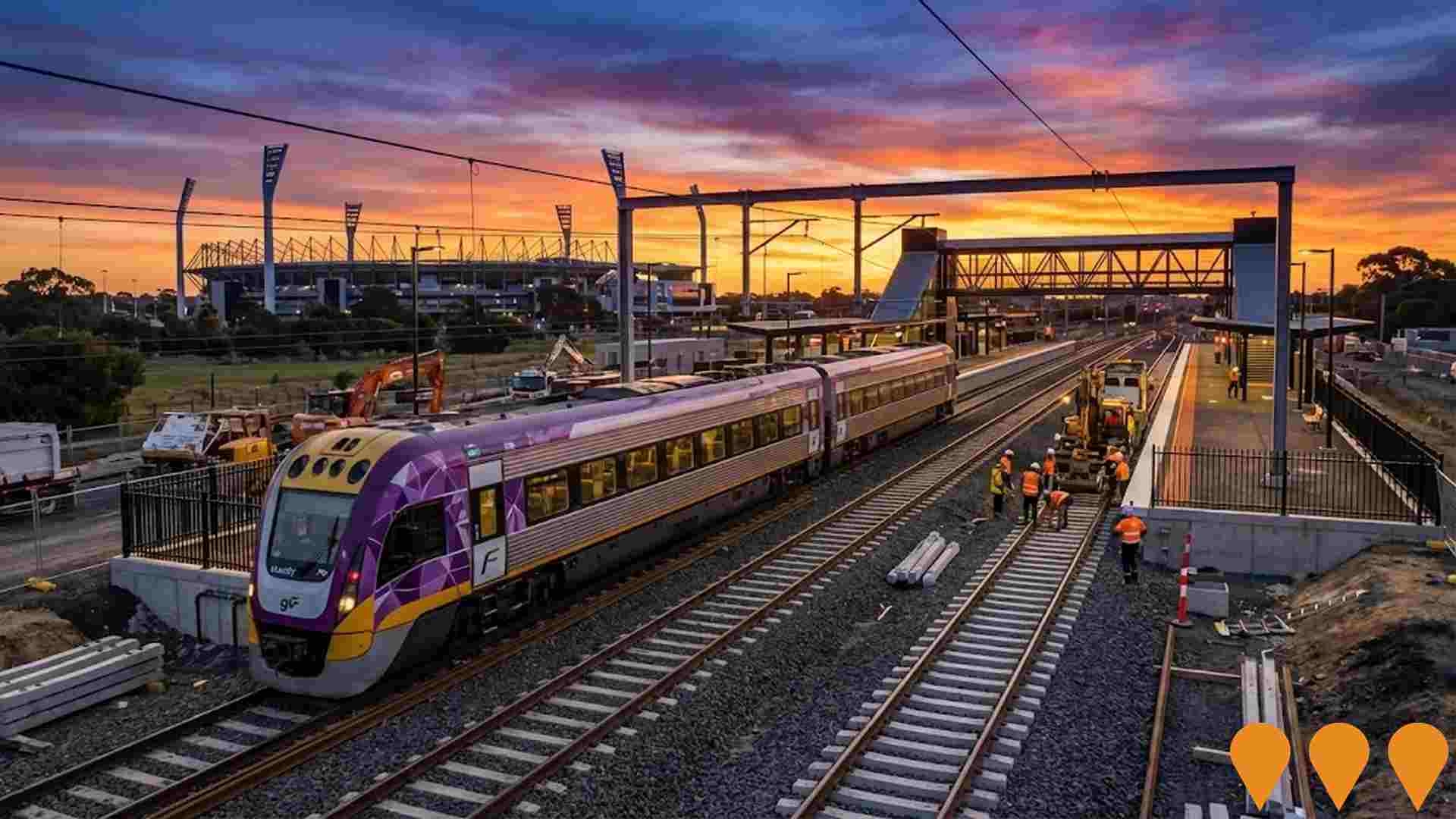
Barwon Women's and Children's Hospital
The Barwon Women's and Children's Hospital is a $708 million dedicated women's and children's facility being built within the University Hospital Geelong precinct. Delivered by the Victorian Health Building Authority in partnership with Barwon Health, the new hospital will include expanded maternity services, neonatal intensive care, paediatric inpatient units, birthing suites, special care nursery, women's health clinics and additional operating theatres. Construction by Built Pty Ltd began in February 2025 and is progressing on schedule for completion in late 2029.
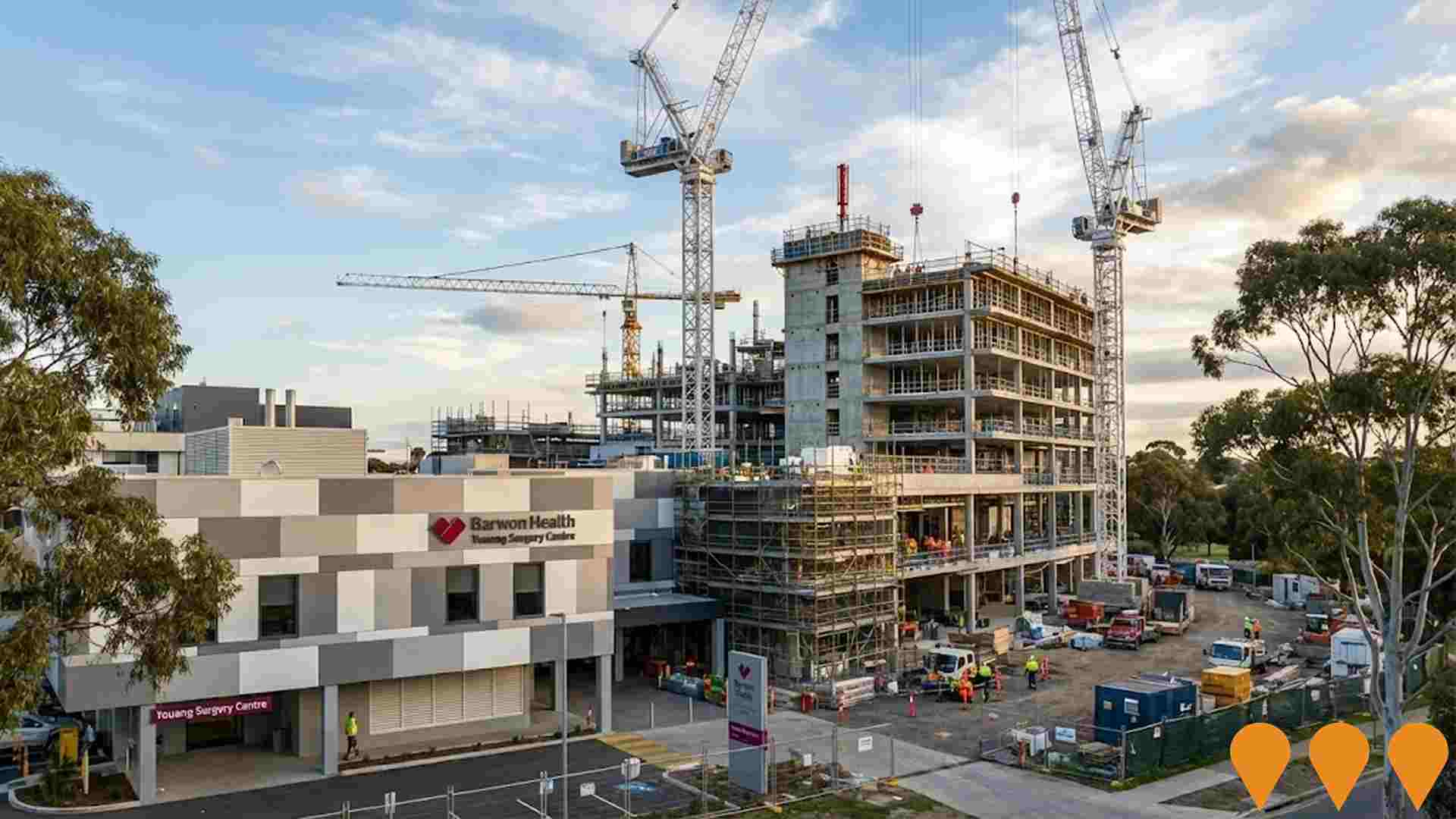
Geelong Renewable Energy Zone (Point Henry Precinct)
One of six declared Renewable Energy Zones in Victoria, the Geelong REZ focuses on the former Alcoa Point Henry site and surrounding industrial land at Moolap. It supports large-scale renewable generation (solar, offshore wind connection, battery storage) and green energy manufacturing including potential green hydrogen and aluminium production.
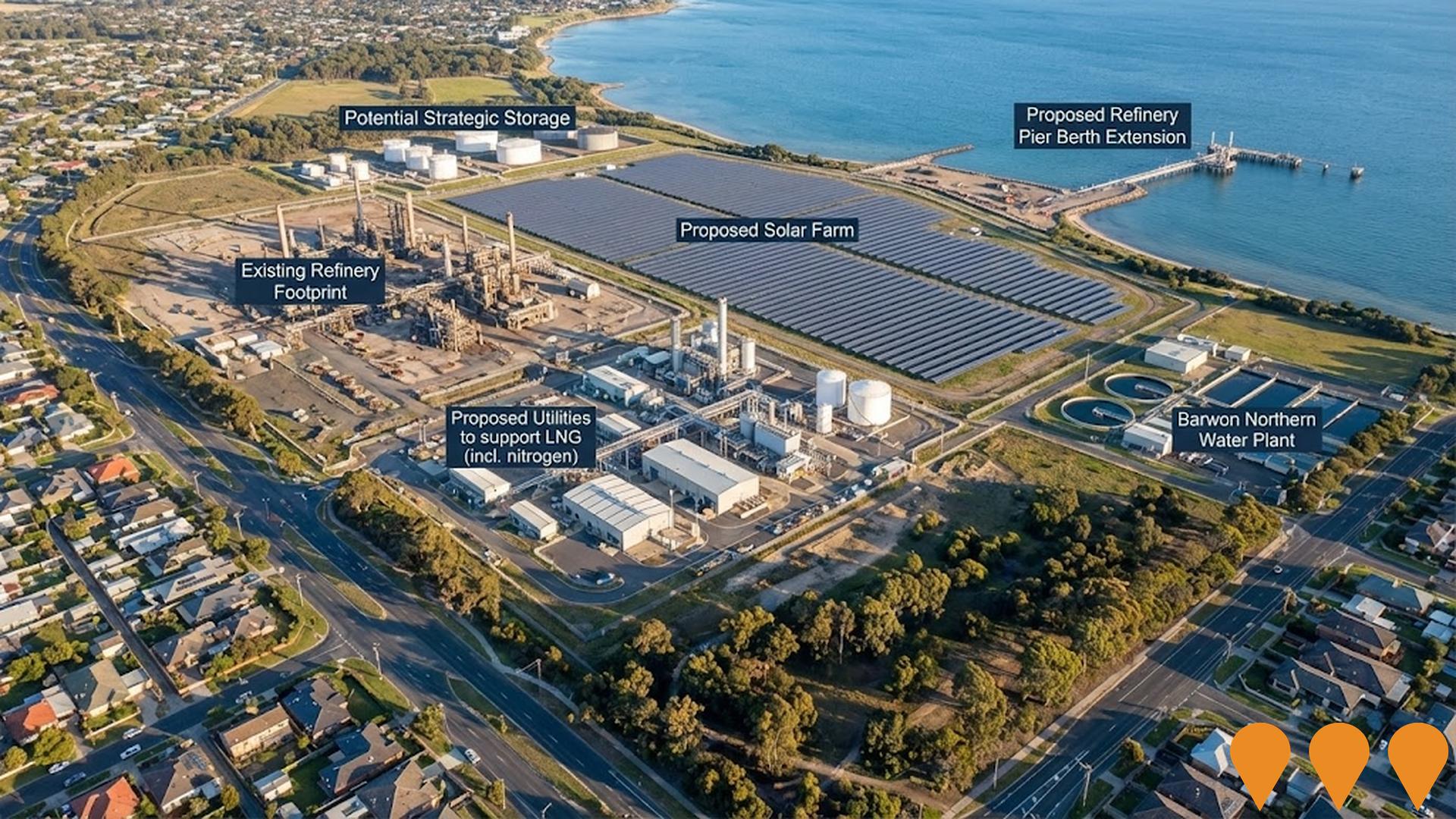
Marshall Precinct Structure Plan
City of Greater Geelong Precinct Structure Plan for a new transit-oriented residential and mixed-use neighbourhood around Marshall Railway Station in the Armstrong Creek growth area. The approved PSP covers approximately 124 hectares and will deliver around 1,555 dwellings (approximately 4,000 residents), local town centre, employment land, community facilities, schools, extensive open space, wetlands and active transport links.
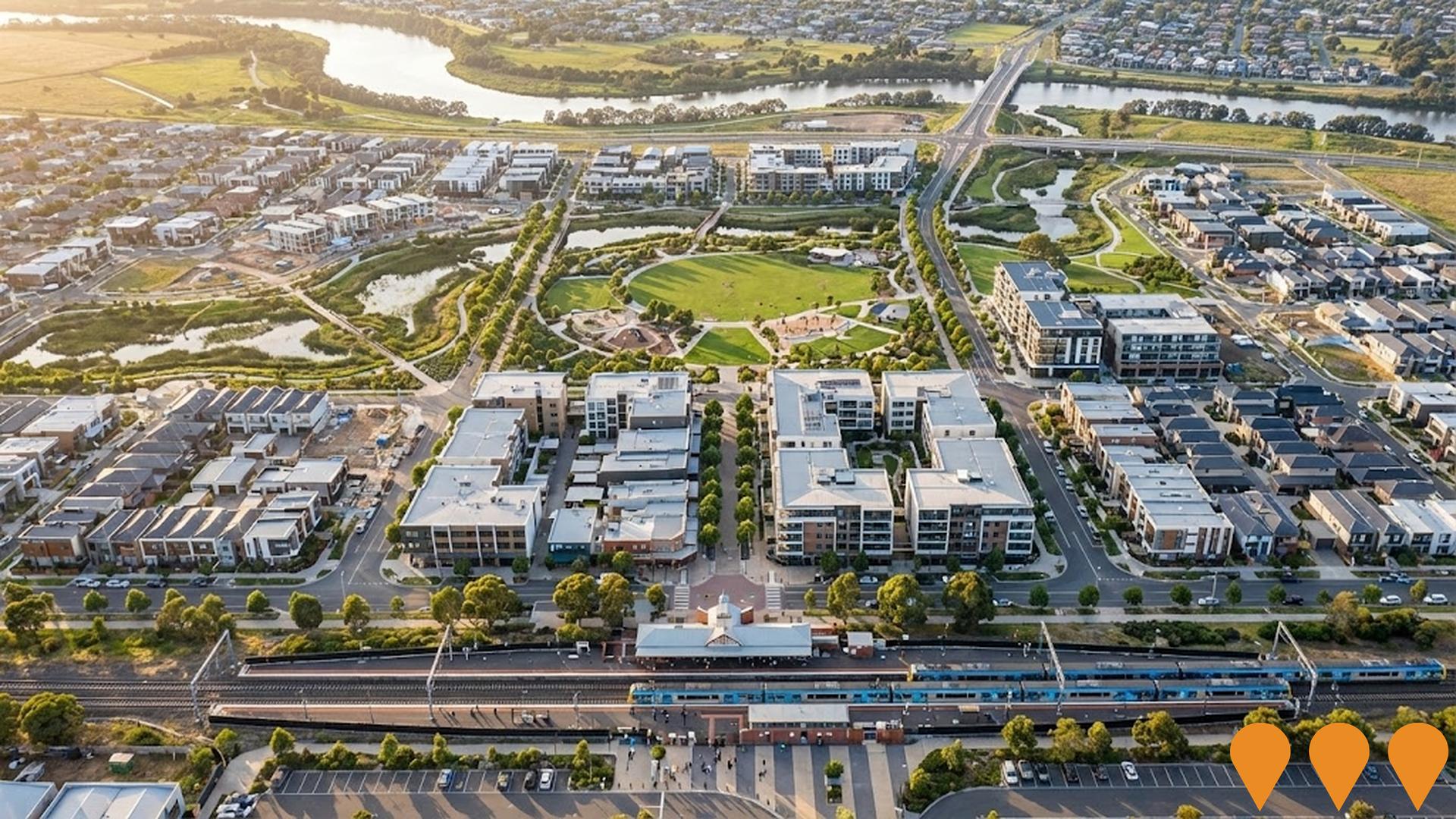
Whittington Family and Community Hub
A proposed multi-purpose community hub at Whittington Link to replace aging facilities and integrate early childhood education, maternal and child health services, neighbourhood house programs (Bellarine Living and Learning Centre), youth spaces, adult education, and community activities. The project is currently at the planning report stage with no funding yet allocated for further planning or construction.
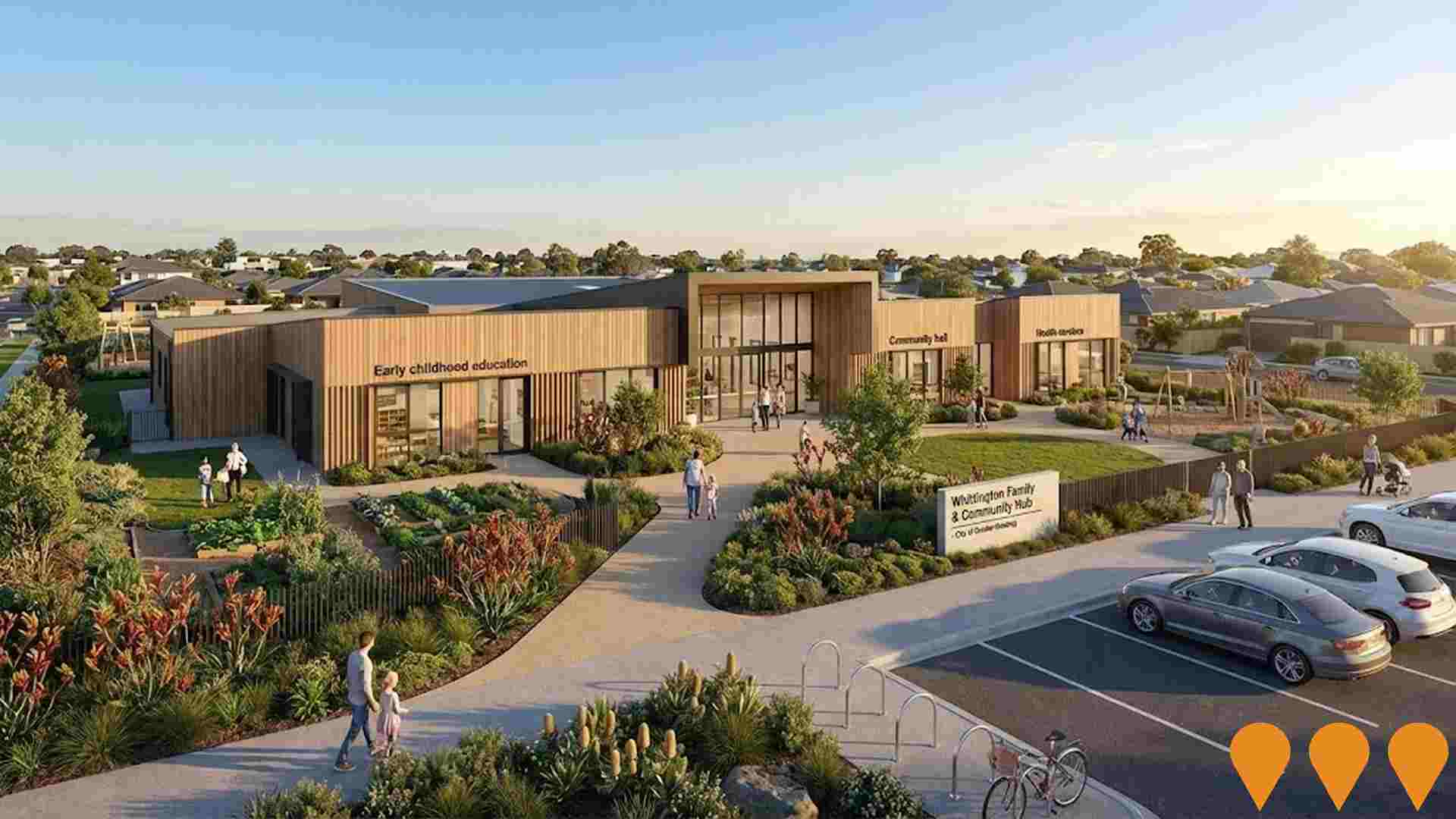
Geelong Ring Road Extension (Bellarine Link)
A proposed extension of the Geelong Ring Road to improve connectivity between Geelong and the Bellarine Peninsula. The project aims to reduce traffic congestion and improve freight access to GeelongPort and industrial areas while supporting regional economic growth. Planned extension between Baanip Boulevard (Surf Coast Highway) and Barwon Heads Road with comprehensive planning including traffic modelling, social studies and environmental investigations.
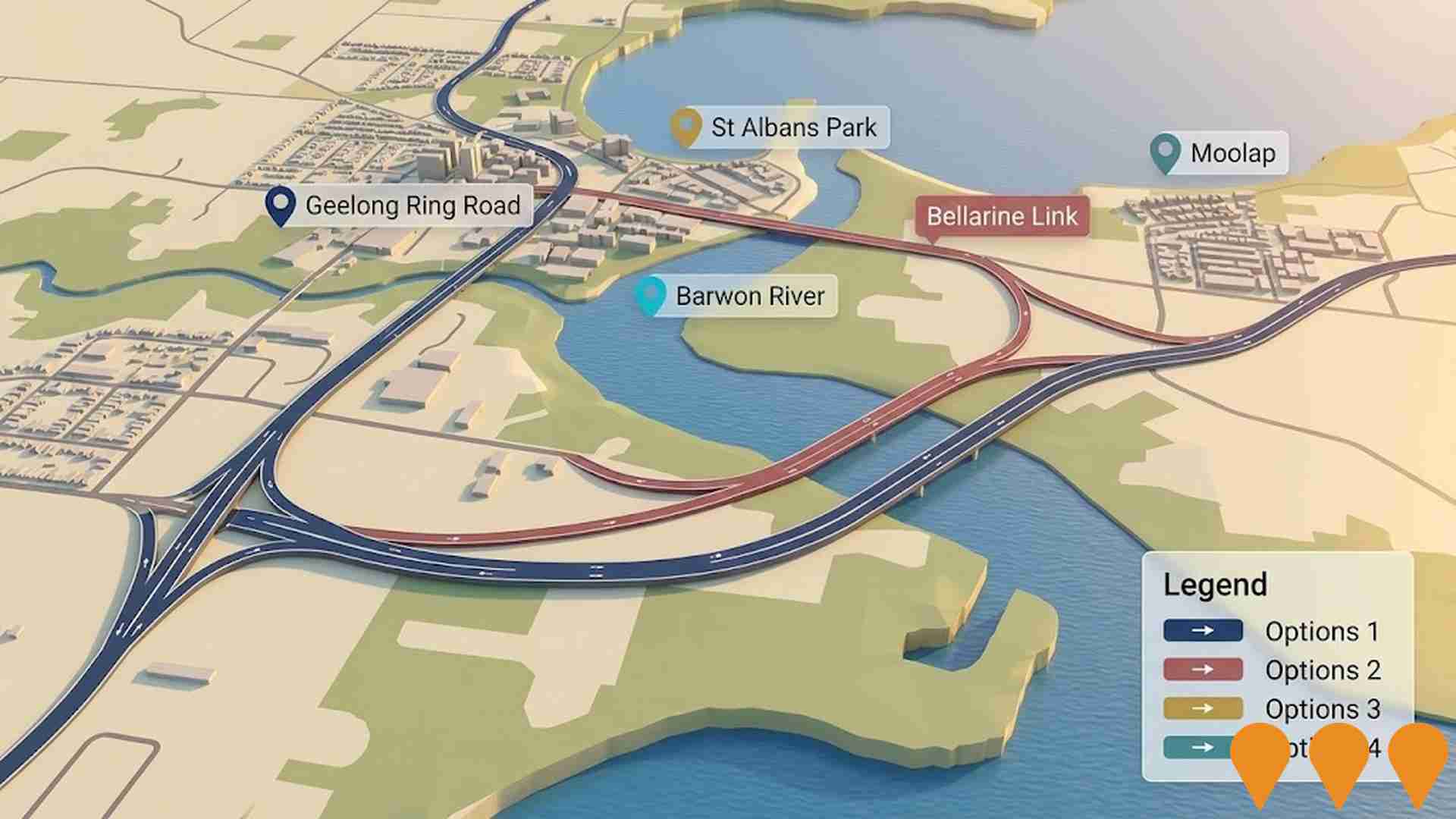
Moolap Coastal Strategic Framework Plan
Victorian Government framework guiding renewal and land use change across northern Moolap including Point Henry and the former saltworks. DEECA is leading the Environmental Management Masterplan for the Wetlands and Former Saltworks Precinct with planning underway 2024-2026, following community consultation in Jan-Mar 2025 and release of an engagement summary in Apr 2025.
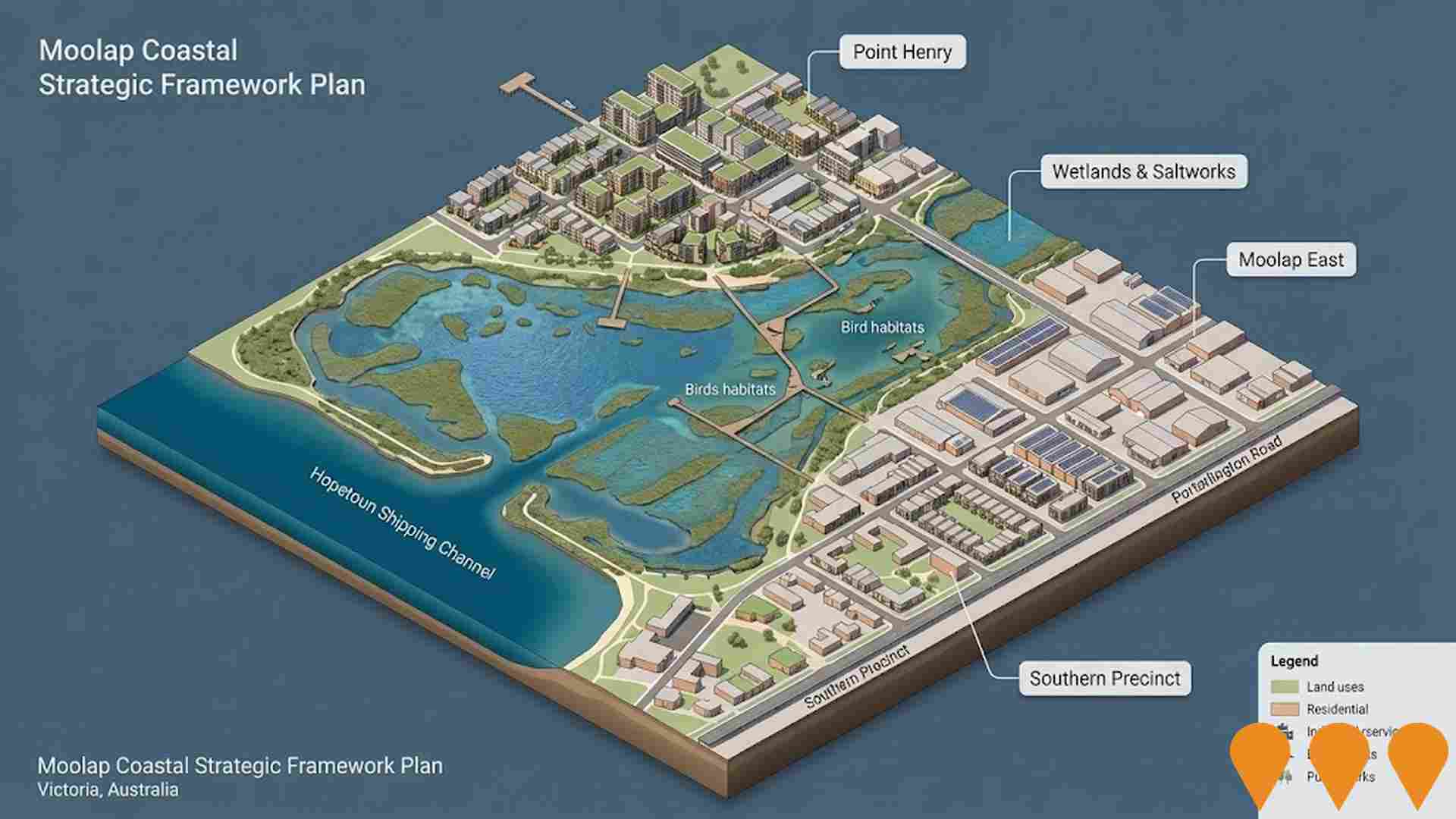
Clifton Springs Water Tank Renewal
Renewal of Barwon Water's largest potable water tank, a 32ML steel storage in Drysdale, to ensure supply security for Clifton Springs and surrounding areas.
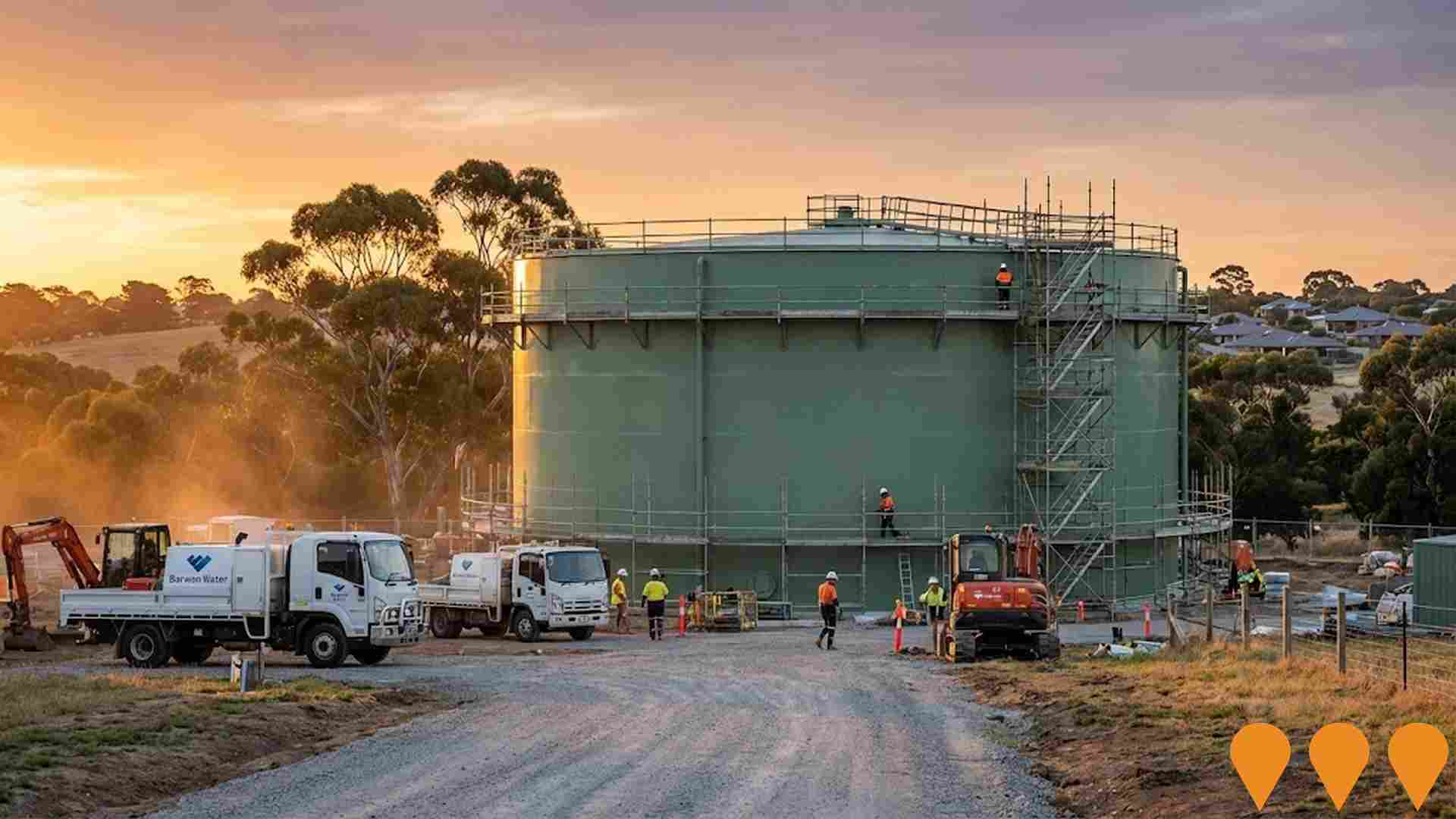
Employment
Employment conditions in Newcomb - Moolap face significant challenges, ranking among the bottom 10% of areas assessed nationally
Newcomb-Moolap has a balanced workforce with white and blue collar jobs. Key sectors include essential services.
The unemployment rate was 8.3% in June 2025, higher than Rest of Vic.'s 3.8%. Employment growth over the past year was estimated at 1.6%. As of June 2025, 7,164 residents are employed. Workforce participation is lower at 53.0% compared to Rest of Vic.'s 57.4%.
Leading industries for employment are health care & social assistance, retail trade, and construction. Retail trade has a higher share than the regional level, while agriculture, forestry & fishing is under-represented. Local employment opportunities appear limited based on Census data comparison. From June 2024 to June 2025, employment increased by 1.6%, labour force by 2.3%, and unemployment rose by 0.6 percentage points. This contrasts with Rest of Vic., where employment contracted by 0.9% and unemployment rose by 0.4 percentage points. Jobs and Skills Australia forecasts national employment growth at 6.6% over five years and 13.7% over ten years, but local projections vary based on industry-specific growth rates. Applying these to Newcomb-Moolap's employment mix suggests potential growth of approximately 6.5% over five years and 13.5% over ten years.
Frequently Asked Questions - Employment
Income
Income figures position the area below 75% of locations analysed nationally by AreaSearch
Newcomb - Moolap had a median taxpayer income of $49,274 and an average of $58,180 in financial year 2022. This is lower than the national average, with Rest of Vic.'s median income being $48,741 and average income being $60,693. By September 2025, estimates suggest the median income would be approximately $55,266 and the average income $65,255, based on a 12.16% increase since financial year 2022. Census 2021 data shows incomes in Newcomb - Moolap fall between the 11th and 15th percentiles nationally for households, families, and individuals. Income analysis reveals that 28.1% of locals (4,279 people) earn between $800 and $1,499 annually, differing from surrounding regions where incomes predominantly fall within the $1,500 to $2,999 range at 30.3%. Housing affordability is severe in Newcomb - Moolap, with only 82.8% of income remaining after expenses, ranking at the 11th percentile nationally.
Frequently Asked Questions - Income
Housing
Newcomb - Moolap is characterized by a predominantly suburban housing profile, with above-average rates of outright home ownership
In Newcomb-Moolap, as per the latest Census evaluation, 86.6% of dwellings were houses, with the remaining 13.4% being semi-detached, apartments, or other types. This compares to Non-Metro Vic.'s figures of 84.6% houses and 15.4% other dwellings. Home ownership in Newcomb-Moolap stood at 34.9%, with mortgaged dwellings at 30.4% and rented ones at 34.7%. The median monthly mortgage repayment was $1,367, below Non-Metro Vic.'s average of $1,863, and the median weekly rent was $300, compared to Non-Metro Vic.'s $375. Nationally, Newcomb-Moolap's mortgage repayments were significantly lower than the Australian average of $1,863, while rents were substantially below the national figure of $375.
Frequently Asked Questions - Housing
Household Composition
Newcomb - Moolap features high concentrations of lone person households, with a lower-than-average median household size
Family households account for 61.5% of all households, including 19.5% that are couples with children, 26.5% that are couples without children, and 14.2% that are single parent families. Non-family households make up the remaining 38.5%, with lone person households at 34.7% and group households comprising 3.7%. The median household size is 2.2 people, which is smaller than the Rest of Vic. average of 2.4.
Frequently Asked Questions - Households
Local Schools & Education
Educational outcomes in Newcomb - Moolap fall within the lower quartile nationally, indicating opportunities for improvement in qualification attainment
The area's university qualification rate is 15.5%, significantly lower than Victoria's average of 33.4%. Bachelor degrees are most common at 10.7%, followed by postgraduate qualifications (2.9%) and graduate diplomas (1.9%). Vocational credentials are prevalent, with 39.9% of residents aged 15+ holding them - advanced diplomas at 10.2% and certificates at 29.7%. Educational participation is high at 25.6%, including 8.3% in primary, 7.1% in secondary, and 3.6% in tertiary education.
The area has a robust network of six schools educating approximately 1,359 students, with typical Australian school conditions (ICSEA: 970) and balanced educational opportunities. This includes four primary, one secondary, and one K-12 school. School places per 100 residents are lower at 8.9 compared to the regional average of 16.7, indicating some students may attend schools in adjacent areas.
Frequently Asked Questions - Education
Schools Detail
Nearby Services & Amenities
Transport
Transport servicing is moderate compared to other areas nationally based on assessment of service frequency, route connectivity and accessibility
The active public transport stops within Newcomb - Moolap total 118. These are served by buses along seven different routes. The weekly passenger trips facilitated by these routes amount to 1,280.
Residents' proximity to the nearest transport stop averages 193 meters, indicating excellent accessibility. Daily service frequency across all routes is 182 trips, translating to approximately ten weekly trips per individual stop.
Frequently Asked Questions - Transport
Transport Stops Detail
Health
Health performance in Newcomb - Moolap is a key challenge with a range of health conditions having marked impacts on both younger and older age cohorts
Critical health challenges are evident across Newcomb - Moolap. A range of health conditions impact both younger and older age cohorts. The rate of private health cover is relatively low at approximately 49% of the total population (~7,446 people), compared to 52.7% across Rest of Vic., which stands at 55.3% nationally.
Mental health issues are the most common medical condition in the area, impacting 11.9% of residents, followed by arthritis at 10.4%. Conversely, 56.5% of residents declare themselves completely clear of medical ailments, compared to 65.9% across Rest of Vic.. The area has a higher proportion of seniors aged 65 and over, with 24.8%, or approximately 3,782 people, compared to the 16.8% in Rest of Vic.. Health outcomes among seniors present some challenges, broadly in line with the general population's health profile.
Frequently Asked Questions - Health
Cultural Diversity
Newcomb - Moolap ranks below the Australian average when compared to other local markets across a number of language and cultural background related metrics
Newcomb-Moolap's cultural diversity was found to be below average, with 87.7% of its population being Australian citizens and 84.6% born in Australia. A majority, 91.4%, spoke English only at home. Christianity was the predominant religion, comprising 47.1% of Newcomb-Moolap's population.
Islam was overrepresented compared to the rest of Victoria, making up 1.3% versus 2.0%. The top three ancestry groups were English (30.4%), Australian (28.9%), and Irish (8.8%). Notably, Dutch (2.2%) and Italian (3.7%) ethnicities were overrepresented compared to regional averages of 2.0% and 3.4%, respectively. Croatian ethnicity was underrepresented at 0.6%.
Frequently Asked Questions - Diversity
Age
Newcomb - Moolap hosts an older demographic, ranking in the top quartile nationwide
Newcomb-Moolap's median age of 44 years is similar to Rest of Vic.'s 43 and above the national average of 38 years. Compared to Rest of Vic., Newcomb-Moolap has a higher percentage of residents aged 25-34 (16.6%) but fewer residents aged 5-14 (8.6%). Between 2021 Census and now, the 25-34 age group has increased from 14.0% to 16.6%, while the 45-54 cohort has decreased from 12.1% to 10.7%. By 2041, Newcomb-Moolap's age composition is expected to change significantly. The 25-34 group is projected to grow by 40%, reaching 3,530 people from the current 2,520. Meanwhile, the 75-84 and 15-24 cohorts are expected to decrease in population.
